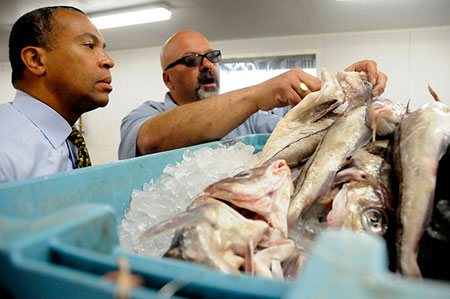 were sometimes hard to believe on Tuesday during the 10th annual buyers' visit and tour of the New Bedford scallop industry.
were sometimes hard to believe on Tuesday during the 10th annual buyers' visit and tour of the New Bedford scallop industry.As the group of buyers from all over the world filled Richie Canastra's online auction room, the price of U-10 scallops from the fishing vessel Inspiration pushed past $17 per pound.
That made boat owner Knute Aarsheim very, very happy as he and his son Keith, the boat's captain, watched the beady but beautiful numbers on the big flat-screen auction display.
Canastra remarked, however, that the day before, U-10 scallop prices reached $19.30 per pound at the boat. (The U-10 "channel" scallops are considered top of the line, excellent texture with no more than 10 to the pound. They are from the rock-filled "channel" fishing grounds, where Canastra said the scallops get a workout as though they're at a gym. And of course the part of the scallops that we eat are the muscles.)
The price was the talk of the day. "Pretty soon we'll be shipping them on Brink's trucks," Canastra joked.
It is actually a little nervous-making to see prices this high. One must wonder whether this is something that can be sustained, or will sky-high prices cause restaurants around the world to start removing them from their menus.
Scallop boats are allowed only about 32 days at sea per year, but scallops are so abundant and lucrative that working on a boat still can be extremely rewarding. Eastern Fisheries' veteran captain Christopher Audette, who after 20 years on the water looks and sounds like someone from central casting, told the foreign visitors that deck hands on his boat took home more than $200,000 last year.
The buyers were incredulous. Surely Audette meant that the crew altogether made that money. He was asked again. No, he said, it was EACH. "And I made more than they did," he said, rubbing it in with a smile. Buyers' jaws dropped. This is what America's No. 1 value fishing port looks like up close.
More amazing numbers: Dr. Kevin Stokesbury of the UMass Dartmouth School for Marine Science and Technology gave the luncheon presentation at the Waterfront Grille (thanks to sponsors Eastern Fisheries and TD Bank).
Stokesbury explained how equipment he and his team are now developing are making progress toward counting fish in real time without catching them, using an open-ended net festooned with lights and video cameras.
His survey team went into the closed area of Georges Bank where regulators think there aren't many fish. His trawl displayed a torrent of fish passing by the cameras, just about all of them edible species, said Stokesbury.
"It was like this the whole time," he said. The trawl covered 175 kilometers, and there was no letup. "We could watch this all day."
The buyers were not only getting a lesson on packing scallops, but on the science and faulty regulation, probably not what they expected when they got on the bus from the Boston Seafood Expo.
Canastra schooled them on the absurd situation on the Hague line with Canada over haddock. On one side of the line, American fishermen catch only about 10 percent of their quota because of rules that so sharply limit yellowtail flounder bycatch that the boats cannot continue fishing.
On the other side of the line, Canadian fishermen fish on the same stock using nets with smaller openings, catch 90 percent of their allocation, then turn around and sell the fish to American processors.
This port is rightly proud of the scallop industry, and with any luck the federal government won't mess it up.
But the rest of the story about our fishing rules is quite the embarrassment. An international embarrassment.





